Don't wanna be here? Send us removal request.
Text
Last Blog #5
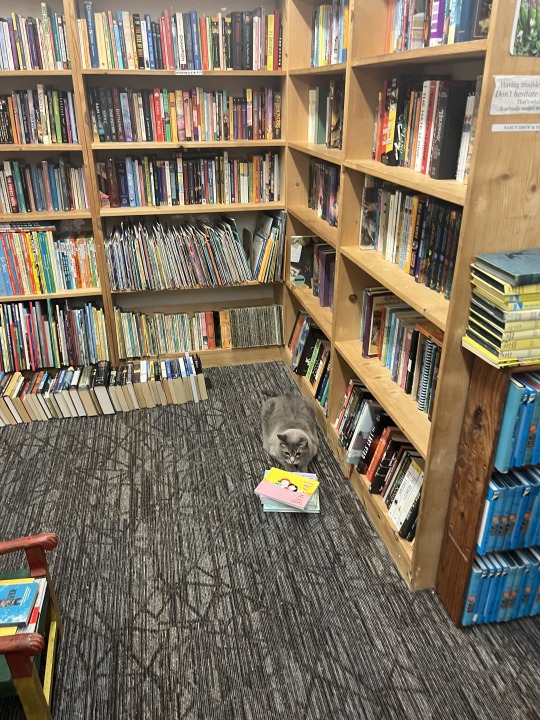
During midterm week, I went to a bookstore nearby that has cats in it!
0 notes
Text
Final Blog #4
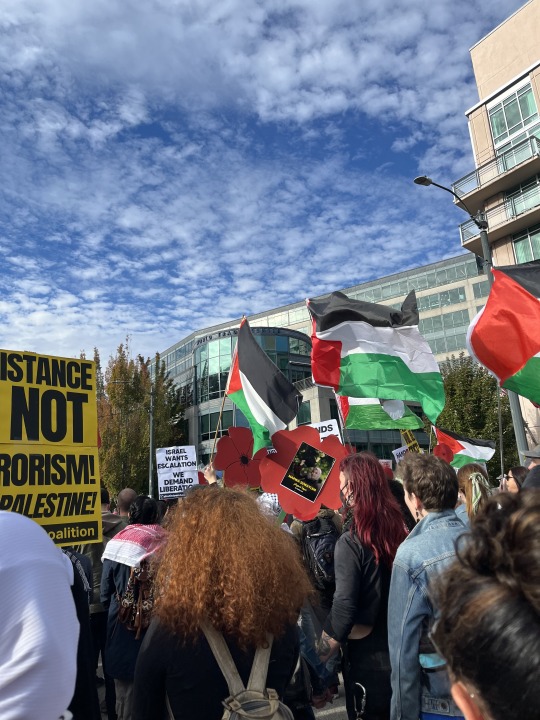
This is a picture I took at a Palestinian protest earlier this year that happened at the waterfront downtown. I feel like I can’t do much to directly help the cause, but I felt like going to the protest and sharing my voice alongside the other hundreds and hundreds of people who went as well could help in some way. As well this class has been helpful in learning new parts of history and allowing me to do research in areas that I am intrigued by. I feel that if I can learn the truth and the history about Palestine, I am already doing something and can help others as well.
0 notes
Text
Final Blog #3
List:
"Immigrant" by Lena Khalaf Tuffaha
"Sad Tunes" by Suleiman Mansour (top right)
"Spring Symmetry" by Samia Halaby
"Breeze" by Malak Mattar
What calls me from these four different items is the resilience that Palestinian women have. That keeping such a rich culture and femininity can be hard during times of war and genocide. The painting by Halaby reminds me of the rich traditional pattern and colors that Palestinians wear. Mansour’s painting shows a woman in traditional outfit playing a flute. This painting is meant to retain traditions through paintings. The woman is drawn in a way that she is seen to be connected to the lands behind her and to the music she is playing. In Mattar’s painting, the main feature of the painting is also a woman, holding a poppy which is a symbolical in Palestinian heritage for many reasons. Its meaning ranges from representing resistance, to the blood shed of fallen people, to the connection to the land. This painting highlights the suffering of women under Israeli occupation. The poem “Immigrant” by Tuffaha describes her experience being at the backseat of a truck leaving Palestine due to the occupation. How she is leaving behind everything she knows, her memories, and her motherland for living in the US. These mediums although may look different and not have many similarities, all tell the story to me of women who may not always be talked about or cared about in situations of conflict, but highlight their experiences and attempts of keeping sane and safe with their heritage.
1 note
·
View note
Text
Final Blog #2
I think that this film is directed in a very specific way that really forces the viewers to be there in the scene and intensifies them. It was a film that took the life of a man and showed how throughout his life, and how things were not getting better at all.
An interesting scene that expands on this idea, would be when the scenes become repetitive (around 39 minutes, at 49 minutes, and at 54 minutes). There are other parts to the repetitive scenes, but this one in specific shows the change that Isrealis had towards Palestinians. The main character is fishing and during the first time, the IDF soldiers ask them where they are from, if they are cold, is there fish, and at the end even tell them to have fun. The second encounter with the IDF soldiers was basically the same. The third time IDF soldiers stop, but leave right away, but later that night they go to his house and accuse him of trafficking guns through the sea and take him to the station. This highlights how the tolerance of Palestinians has lessened over the years that Israel has occupied the area.
Another scene that was interesting to me was when the mayor of Nazareth (around 9 minutes) was signing papers to give control to the Israeli government of the city as well as arms had to be surrendered. He had no option but to sign, but as a consequence it led the IDF to start raids and shooting fire at buildings and people with no reason. This scene resembles all the documents and treaties that Israel signed, were really with no genuine consent of any Arab leader. They had already started occupying and invading, which led to the Arab leader not having much power left.
This film works with the historical materials and documentary series because of the events that occur during the film. There are mentions of liberation of Haifa in the beginning of the movie, as well in the third episode of the Al-Nakba documentary that was played during class. There are other examples such as showing the rampant violence towards innocent Palestinians, the stealing of possessions that were of one of Palestinians who were kicked out of their homes. There are many other examples, but this shows that even though it is a film, it still covers the experiences and reality of Palestinians during that time.
0 notes
Text
Final blog #1
I decided to read the poems because I feel that it is a part of literature that isn’t really covered in middle school or high school. I think that these poems are very personal to Lena Khalaf, they seem to focus on her personal experience as an immigrant, as a mother, as a daughter, and to her connection to her language and motherland. I feel like I feel the emotions that Khalaf had while writing her poems, especially “Grandmothering”. While I don’t have a close relationship with any grandparents, this more resonated with my mother. When he would do my hair, I could feel the nostalgia.
0 notes
Text
Required Post 7.4
The election result has been very stressful to me, I will be honest. Being that my parents are immigrants, it scares me of what their future can be once Trump gets back in the office. It is unimaginable that my parents who have been in this country for over 20 years, are law-abiding citizens, pay their taxes, could be deported back into Mexico and lose all that they have built here. For me, the threat of denaturalization is scary, that I could lose my citizenship although I was born here. The anti-immigrant rhetoric is becoming more violent and more insane by the day, and it scares me of the possibilities that create. Such as Trump threatening to invoke the Alien Enemies act to help process the deportation of undocumented immigrants.
As a women, I fear that even though I live in a state where my rights are protected, it will not be the same case in another states. Women will die because they will not have access to the right resources and healthcare. As Well the threat to restrict contraceptives and IVF are also on the line. Aswell switching from safe sex education to abstinence-only education is a harmful choice and has been proven to not help. We will see an increase in teen pregnancy and as a result of women’s healthcare being restricted, will not have as much resources to get through a scary time.
There are a lot of other reasons why this election is scary, but these issues are very personal to me!
0 notes
Text
Required Post 7.3
The topic chosen is about Trump’s choice of nominating and choosing Representative Matt Gaetz as attorney general. This is a very controversial choice, to both parties. All of Trump’s new appointees have all had controversies that should question their role in this new administration. Matt Gaetz in specific, has been accused of being involved in sex trafficking and taking a minor across state lines with the intent of having sex with her. This will be a comparison on how Fox News (conservative), ABC (liberal), and Axios (moderate) cover the topic.
In the Fox News article, what stands out is only mentioning once that he has allegations regarding “sexual misconduct with a minor and illicit drug use”. They do not mention any more details regarding the case, except that there is an ethics report coming out soon. The article further has quotes from other republican representatives either pleased or surprised with the fact he has been nominated for the role.
In the ABC article, they go further into details of the case. Stating that his friend was sentenced in 2022 for 11 years for similar charges that are being accused of Rep. Gaetz. They both talk about the ongoing ethics report. This article goes into how loyal he is to Trump, which the Fox article fails to mention. It reports that Gaetz has been “in Mar-a-Largo almost every day since Election day” and “seen traveling with Trump in his motorcade.”
In the Axios report it is less of a standard article and more bullet point information about Rep. Gaetz. They list details first about his background, then into his investigation, about how close he is to Trump, and other controversies.
All the articles mention that Rep. Gaetz 'choice of resigning before being officially appointed will affect his report, as technically he is not an official member of the House anymore. What I make from this, is that conservative media realize that this is a controversial choice but still has to back him up. This is a reason why the details of the cases are not mentioned in detail, or that his friend was charged for the same allegation. While liberal media tells the most important parts of the case, which serve their purpose in stating that Trump is putting his loyal allies into positions and not for their qualifications. A way in this case, that you can resolve the truth is look for what is mentioned in the articles across the political parties, finding the source (which could be hard because this is an ongoing investigation and documents may not have been released yet), or finding a moderate page that does not contain bias towards any political party.
Works Cited
Habeshian, Sareen. “What to know about Matt Gaetz, Trump's attorney general pick.” AXIOS, 13 November 2024, https://www.axios.com/2024/11/14/matt-gaetz-trump-attorney-general-pick-what-to-know. Accessed 16 November 2024.
Steakin, Will, and Rachel Scott. “Matt Gaetz resigns from Congress after being picked for attorney general.” ABC News, 13 November 2024, https://abcnews.go.com/Politics/trump-picks-rep-matt-gaetz-attorney-general/story?id=115835796. Accessed 16 November 2024.
Wallace, Danielle. “What happens to the Gaetz House ethics report?” Fox News, 14 November 2024, https://www.foxnews.com/politics/what-happens-gaetz-house-ethics-report. Accessed 16 November 2024.
0 notes
Text
Required post 7.2
The message that these sources are cumulatively state that Britain strategically planned a “Jewish state” half a decade before the “creation” of Israel in 1948. The existence of the Campbell-Bannerman report in 1907 shows that Palestine has been an idea for the British to use as a “buffer state” and to have it be a friendly territory in the middle east, while being a competitor with the Arab World. (Karatas) This paper was written during World War I, and it would be useful for the British to have one more dominated country that they could use for their advantage during a war. As well in this report it called for a Jewish state in Palestine, after failed attempts of creating a Jewish state in Argentina and Uganda. Another reason, for the push of a Jewish state, was that Britain and a lot of western Europe were very anti semitic and wanted to move Jewish people out. In most of these sources, it shows the explicit attempts of moving Jewish people into Palestine, through agreements between the British parliament or other western european countries.
In 1915, a memorandum was presented to the British Cabinet by Herbert Samuel that highlighted many reasons why it would benefit Britain in pursuing a Jewish state in Palestine. An example mentioned would be,
“ The inclusion of Palestine within the British Empire would add a lustre even to the British Crown. It would make a most powerful appeal to the people of the United Kingdom and the Dominions, particularly if it were avowedly a means of aiding the Jews to reoccupy the country. Widespread and deep-rooted in the Protestant world is a sympathy with the idea of restoring the Hebrew people to the land which was to be their inheritance, and intense interest in the fulfilment of the prophecies which have foretold it” (Samuel)
This quote highlights again how the creation of Israel was not necessarily in helping Jewish state, but that it would look great for Britain and its citizens. Aswell it mentions the Zionist Protestant who believe if Jewish people reclaim the holy land, the rapture will occur. It highlights that it is much deeper than a quick land grab, but there will be restructuring in how people will view the zionist ideology and the British Empire’s power.
In just a few years after this the Sykes-Picot Agreement (1916) and the Balfour Declaration (1917) solidified the Zionist ideology and the creation of the “Jewish state”. In the Sykes-Picot Agreement, France and Britain secretly outlined their control over the Arab countries with no consultation to any leader of the Arab world.
These sources led me to realize that the work behind creating Israel was happening way before 1948. I knew that the existence of Israel in the middle east will help the western countries destabilize the middle east, and the use of the Suez Canal. But, with this research, it led me to realize there are way more reasons that Britain pleased the Zionist ideology.
Works Cited
“The Avalon Project : The Sykes-Picot Agreement : 1916.” Avalon Project, https://avalon.law.yale.edu/20th_century/sykes.asp. Accessed 16 November 2024.
Heaney, Christopher. “"Future of Palestine" Memorandum by British Cabinet Member, Herbert Samuel - Question of Palestine.” the United Nations, 22 January 2021, https://www.un.org/unispal/document/future-of-palestine-by-herbert-samuel-government-of-united-kingdom-memorandum/. Accessed 16 November 2024.
Karatas, Ibrahim. “(PDF) Was Israel a Western Project in Palestine?” ResearchGate, 2020, https://www.researchgate.net/publication/347151281_Was_Israel_a_Western_Project_in_Palestine. Accessed 16 November 2024.
Tripier, Maurice, and Adelheid de Rothschild. “The Family ‹ Family interests.” The Family ‹ Family interests :: The Rothschild Archive, https://www.rothschildarchive.org/family/family_interests/walter_rothschild_and_the_balfour_declaration. Accessed 16 November 2024.
0 notes
Text
Required Post 7.1
The sources listed all have a similar message. That is that the Palestinian identity was not included in any of the meetings regarding the existence of Israel.
The first source is regarding a Zionist conference taking place in New York in Baltimore (Nordau). This meeting was deliberated schedule in New York, as a large population of Jewish people live in. One possible idea of this was that if they convinced some jewish people to believe in the zionist ideology, then it would put the plan further into action. As well, the intention behind spreading the zionist proposals into American society, was part of the reason behind the location of the conference. In this meeting, the talk of unrestricted immigration into Palestine. No comment on how this will affect the people living in Palestine was mentioned.
Another case of this happening, is when the Arab League was formed in March 1945, Dr. Husayn described that the League had removed references of Palestine and their choice of not having any Palestine representation (H. Khalidi). Dr. Husayn is the author’s uncle who was part of the Arab Higher Committee that was taken down by the British in 1937 and he and fellow members were imprisoned and exiled (Shahid). This highlights the silencing of oppositional groups and voices that subjugations the Palestinians and their attempts of liberation.
Further down the road, when multiple conferences would be held in popular western cities, they told Palestine that they had “no official standing” since their meetings were private and not official (R. Khalidi). This was the method the western world would exclude any mentions of Palestine and therefore receive no backlash or counterarguments.
Unfortunately the rising of the Zionist ideology and their belief of superiority over the Arab identity has led to subjugation of the Palestinian society. This response made me realize how desired the prospect of having a western presence in the middle east was. That they would do anything to make sure that no stories of how aggressive this ideology was on the population of Palestine would come out.
Works Cited
H. Khalidi, Mada ‘ahd al-mujamalat, vol. 1, 434-36
Nordau, Max. “The Biltmore Conference (1942).” Jewish Virtual Library, https://www.jewishvirtuallibrary.org/the-biltmore-conference-1942.
R. Khalidi. The Iron Cage. 2006, 41-42
Serene Husseinii Shahid, Jerusalem Memories. (Beirut: Naufal Group, 2000), 126-27 (22)
0 notes
Text
Required 6.5
As a mexican, I am excited for Mexico's future, with the new president of Mexico, being a successor of the previous president. I think that Mexico will see much more improvement. One of proposal that I was the most excited for in Obrador's administration was the development of high speed rail in Mexico, called Tren Maya. Sheinbaum wants to extend the line and connect the US's border cities to major cities in Mexico. This is exciting as it gives an alternative service then driving!
I am a fan of high speed rail, and I think its a disappointment that we don't have a large network of high speed rail that could take me to other parts of the country and it being affordable. Amtrak's funding from the government has been decreased frequently and it is not very affordable. California is just starting to develop a line from LA to LV which I like! But unfortunately I look at Japan, China, Europe, and realized how far behind we are compared to them in public transportation.
0 notes
Text
REQUIRED BLOG 6.4
The movie Alephia 2053 is about a town that has a clear wealth disparity and is split in two. The “lower” Alephia is where the oppressed group lives. They have no access to a stable water source, are under severe surveillance by the oppressor, and are exposed to the beatings of the militarized police force. This movie relates to the current events going on in Gaza. Such as the IDF having no repercussions for their actions against the Palestinians population, are under heavy surveillance to the point where Israeli government knows, and social inequalities.
In the film, the militarized police would beat up civilians for being accused of their son being part of a revolutionary group (4:10-4:28), torturing prisoners who are children(11:49-13:19), and shooting at protestors (52:12). These are all examples of how abusive police forces can be with their power if the state is behind them in their actions. They receive no consequences and as a byproduct causes rampant violence towards the marginalized group. The IDF has been notoriously known for being brutal towards Palestinians with no backlash and have been accused of all of the atrocities that the militarized police force in Alephia has done. An IDF soldier reported to The Guardian about the beating of a 14yrd old boy and said, “finding a thick wooden board in a field, sitting him on it and smashing his balls for several minutes…kicking his balls.” Another way that shows the IDF’s power is with their creation of what are basically concentration camps in which they torture Palestinians. A report from B’Tselem stated that the “Facilities in which every inmate is deliberately subjected to harsh, relentless pain and suffering operate as de-facto torture camps.” These examples show the parallels between the offensive forces in Alephia and in Israel. Both commit brutality and are sponsored by the government which leads to unrestrained power.
Heavy surveillance is a common recurrence in the film. At many points you see drones flying around, the government being able to pinpoint the exact location of any civilian, and having a statue in Lower Alephia that monitors their daily lives. An example from the film is of the 17yr old boy named Mayyar Ali who is being accused of being part of a revolutionary group, the government is able to track him and find out he is near the border. They are able to get to him and publicly hang him. (10:17-13:41) Israel has been known to control the Palestinian population registry and has killed the families of journalists in their house. They also use facial recognition at checkpoints and cities in the West Bank which also are covered in security cameras. A report from Amnesty International states that “Red Wolf [a surveillance network] is deployed at military checkpoints in the city of Hebron in the occupied West Bank, where it scans Palestinians’ faces and adds them to vast surveillance databases without their consent.” This highlights the similarities of the film and current events. How oppressed groups are being always watched and tracked, which makes them feel small and belittle, and feel fear as their every step is being analyzed.
A direct quote from the film that word by word can be used to describe the condition in Gaza is when the leader of Alephia stated that “With external support, we defeated them. I annihilated them to instill fear. I built a wall of blood between us, and made the prison transparent” (7:56-8:10). Israel is backed up by most western countries, with the US being its biggest ally. The US has given over $158 billion since the founding of Israel. Alongside, they receive bombs and fighter jets that the US regularly ships to them. This leads Israel to be more militant than the regular civilian, and even revolutionary groups, which leads to the elitism of Israeli society. Such a mindset is one of the reasons why there is now a wall between Gaza and Israel. This wall prevents free movement of Palestinaens, which is commonly called by human right organizations as “the biggest open air prison”. The quote is an verbatim of the reality of two million people who live in the Gaza strip. They have to endure bombing campaigns regularly with no place to go as they are trapped and including the dismissal of their issues by the western world due to their alliance with Israel. The quote and its parallels in the real world display the inequalities of societies under an apartheid.
The film Alephia 2053 exhibits resemblances to the current events happening under Israeli apartheid where Gazans are subjected to state-sponsored violence, intense surveillance, and living conditions that are unimaginable. Alephia 2053 represents a population that are living under an apparent apartheid where they are exposed to a group that views themselves as superior and do anything to belittle the marginalized group; such as how Israel portrays Gazans to the rest of the world.
Works Cited
https://www.theguardian.com/artanddesign/2022/dec/15/idf-exhibition-breaking-the-silence
https://www.btselem.org/publications/202408_welcome_to_hell
https://www.amnesty.org/en/latest/news/2023/05/israel-opt-israeli-authorities-are-using-facial-recognition-technology-to-entrench-apartheid/
https://www.reuters.com/world/middle-east/us-has-signed-off-more-bombs-warplanes-israel-washington-post-reports-2024-03-29/
0 notes
Text
Required Blog 6.3
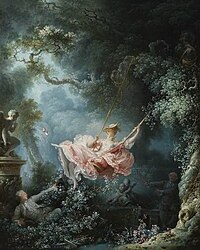
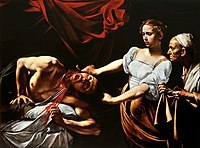


Top Left: Rococo art style, Top Right: Baroque art, Bottom left: Classicism art, Bottom right: Romanticism art
These are all paintings done from different eras or styles. Each art has a characterized style which is what separates them from each other. Rococo Art Style was popular from the mid to late 1700s. Classicism art was found between the periods of mid to late 17th century. Baroque art was found in the late 16th century to early 18th century. Romanticism art was popular in the late 18th century to mid 19th century. While the paintings may have differences in the lighting, in the color palette, the way the people are drawn due to the era the painters were in, across the board they would draw women in a similar way.
The women are drawn in flowy dresses, almost in a sensual way, no matter the context of the painting. The romanticism painting featured is a representation of the execution of a teenage girl. Yet in the worst moment of her life, she is portrayed in a soft lighting and her dress perfectly flows of her body. I am puzzled as to why artists would draw women for this. Is it due to sexualization of the women's body, or the idolization of the women's body? Is it due to the prominent idea of women at the time of high class are women who are soft and vulnerable or that these painters were appreciating the women’s body? It feels that no matter the period of art or the context of the painting that was popular in Europe, women were drawn in a way where it feels that sensuality and lust is radiating from the painting.
An interesting complexity in my argument is regarding the Baroque painting featured, where the lady itself is committing the execution. She is not being portrayed as the classic tale that women are soft and need protecting, as she is the person behind the murder. This painting uses much stronger and darker tones compared to the other painting. The story behind the painting is based on a biblical story of a woman killing a general. Yet, regardless of the dark nature of the women, she is in a silky white dress and her hair is nicely done. She has facial expressions that describe disgust, which could represent her regret or the messiness of executing someone. Yet even after all that, she still has porcelain skin.
No matter the subject of the painting, or the style, women tend to be portrayed in a way that promotes the submissiveness of women. That even if they commit crimes, they are still subjected to being in the light and having soft skin.
0 notes
Text
Required blog 6.2
I have liked the book so far. I think that the deadlines are not very defined, which is why I feel the class is a little confused. The book itself is fine, I think the author jumps from one event to another, or from one year to another, but by putting your full attention into comprehending the story, I feel like you can make most of it make sense. I am interested in how the book will go (I am only on chapter 5).
I find it interesting that he viewed Nael’s change in personality and lifestyle surprising. I feel like with the childhood he had and his father had, it makes sense. A kid who had a super rough childhood, where his dad has a second family he prefers, it makes sense that he wants to move away and start a new life.
I think you mentioned something about why he chose the fine arts path, I think its because for the first time in his life, he had freedom. So much was suppressed in his childhood, and art is a typical field that people associate with freedom, expression, and creativity, it makes sense in a way that Nael would adventure in that field. It was his way of being his own person and identity, after growing up under his absentee father.
I think it's hard also to comprehend the book knowing that the events going on in the book are happening right now in many places. Knowing that I can’t do much to help the cause, and that taxpayer money is going straight into the suffering of innocent people such as Hishman and his friends makes me hopeless, I will be honest.
(UPDATE) I’m writing this update after Monday’s class. I am on chapter 15, and I think it's an easy book to read and follow when I pay my full attention. I think that sometimes it can be hard to talk about it due to the complexities of the story and the events that occur. Occasionally when I’m reading, I circle back to what is happening in Lebanon or in Gaza, and it makes it kinda hard to keep reading. I think that I would like to continue reading the book, because as you said, we shouldn’t stop because we are uncomfortable, if anything it is a sign to keep reading!
0 notes
Text
Required Blog 5.4
I decided to buy a digital camera that when you take a picture it comes with the quality of a 2000s photo. I was not expecting much great quality since it was 30 dollars. But I took it on my hike on Mount Si which I did with UREC and took some photos!
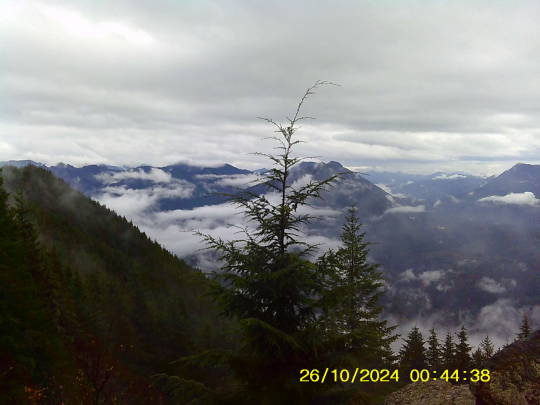
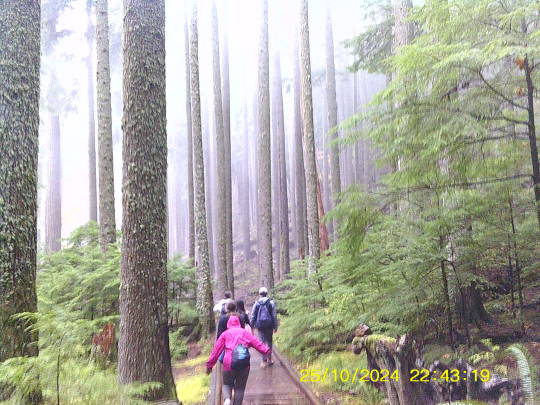
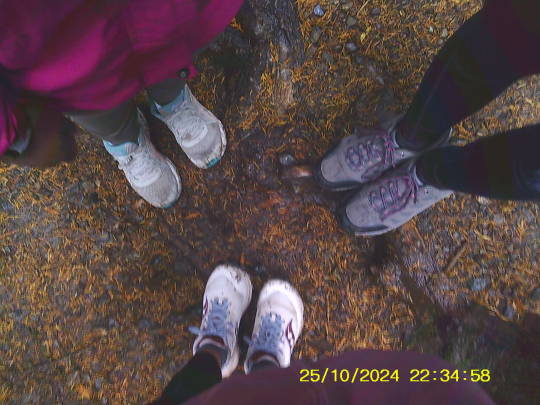
I am hoping to use this camera more to record more special memories in my first year of college!
0 notes
Text
Required Blog 5.3
Lebanon's civil war occurred from 1975-1990, it involved a power imbalance and a great wealth disparity between Christians and Muslims.
In 1943, Lebanon gained independence which then an unwritten agreement called the National Pact, allowed for a parliament where there was a 6-to-5 ratio of Christians to Muslims. Although Muslims had been in the area for much longer and were a bigger population in Lebanon compared to Christians. By 1970, Muslim comprised 60% of the total population and wanted more government representation
Israel, around this time trained and supplied a right-wing Christian Lebanese militia to strike back at PLO (Palestine Liberation Organization) due to a large population of Palestinians moving to Lebanon.
In 1975, four christians were killed and an attempt on the leader of the Christian militia was made. In retaliation, they killed 26 innocent Palestinians.
These events and multiple other similar events caused the country to begin to turmoil and increase violence within religious group. Beirut was separated into two parts, where one community dominated one side, and the other religion the other side.
This helps complete the story as it is a much deeper rooted issue than the movie gives. It goes much further than a city fighting within each other, but that the whole country was in the same place. It contextualizes the Lebanese Civil war and much of it affected the daily lives of cities that once were peacefully coexisting. That the movie is more than a portrayal of feminism and defeating the Orientalism lens that is placed on Arabic women, but that it shows the intricacies of a community ridden with hate and how it crumbles society and community
Works Cited
Frontline World. “FRONTLINE/WORLD . Lebanon - Party of God . Bullets to Ballot Box: A History of Hezbollah . 1975-1979: Civil War.” PBS, https://www.pbs.org/frontlineworld/stories/lebanon/tl01.html. Accessed 30 October 2024.
Wenger, Martha. “Primer: Lebanon's 15-Year War, 1975-1990.” MERIP, Jan/Feb 1990, https://merip.org/1990/01/primer-lebanons-15-year-war-1975-1990/. Accessed 30 October 2024.
0 notes
Text
Required Blog 5.2
I chose a current event which is Israel striking the Baalbek region, which is a historical town in Lebanon. I found three articles, The Nation, Associated Press, and BBC, that are covering the same attack that left at least 19 people dead.
In The National, they state that the Israeli military claims they striked Hezbollah targets in Baalbek, yet most of the casualties were civilians. They talk about other attacks that Israel has committed in different areas in Lebanon. They talk about the ground invasion that Israel has started. The main picture of the article is of a child being hospitalized. They include a few primary sources which include,
The mayor of Baalbek, Mustafa Al Chal, giving a quote to the newspaper about how there was evacuation warnings and the people had to be displaced outside of the city limits to “mostly christian areas”
They also collected quotes from residents from the Baalbek area, that they were called by the Israeli army to “leave immediately”
Regarding the quality of this article, they have more articles focusing on the stories of people who had to be hospitalized in Baalbek and talking to them. They include pictures and multiple quotes of victims who suffered Israeli's strikes.
In the Associated Press, the front picture is of rescue workers carrying the body of a boy who was under the rubble. They start the article by stating that at least 19 people were killed, and then stating that evacuation orders were sent hours prior. The wording or framing felt a bit off. They mention Hezbollah more as the reason why Lebanon is being attacked than Israel. Such quote as, “when Hezbollah began firing rockets into Israel drawing retaliation”
They mention the genocide in Gaza, but they call it “Israel-Hamas War”, and it states that the death count does not distinguish between civilians and combatants. I am not sure of the relevance of this comment. Is it to prime the American audience to doubt the death count and how many of those 43,000 are “innocent”. They also state that this “war” started on Oct. 7.
There is no primary sources and it is a much shorter article. The quality therefore is not high due to no primary sources, sketchy framing, and being short.
In the BBC article, the front image is the smoke and aftermath of one of the strikes in Baalbek. They mention the same, 19 people dead, evacuation orders, but it did add a fact that the evacuation order was not just for Baalbek, but two other towns. They have a section on how Baalbek is an “strategically important for Hezbollah” and how the city plays a role for Hezbollah.
Regarding primary sources, they had a quote from the mayor as well, and others such as UNESCO, US department spokesman, Israeli military. But not one quote from someone who was on the ground, who witness Israeli's strikes.
Regarding Quality, BBC is as well a respected source, but a western source nevertheless. BBC would call the Gaza’s health ministry the “Hamas-led health ministry” for a while, which contributed to the downplay of Israeli’s action in Gaza. As well they have no primary source of a direct victim, instead have sources from governments or outside people.
Works Cited
Associated Press. “Middle East latest: Israeli airstrikes pound the eastern Lebanon city of Baalbek.” Associated Press, 30 October 2024, https://apnews.com/article/israel-hamas-hezbollah-mideast-latest-30-october-2024-32c614e64e8959768ac3f50aa67548ea. Accessed 30 October 2024.
Gritten, David, and Hugo Bachega. “Israel strikes historic Lebanese city of Baalbek after ordering evacuation.” BBC [London, Beirut], 30 October 2024, https://www.bbc.com/news/articles/crez85y20zvo. Accessed 30 October 2024.
Prentis, Jamie. “Israel begins attacks on Lebanon's Baalbek city after ordering all residents to leave.” The National [Beirut], 30 October 2024, https://www.thenationalnews.com/news/mena/2024/10/30/dozens-killed-and-injured-in-israeli-air-strikes-on-south-lebanon/. Accessed 30 October 2024.
0 notes
Text
REQUIRED BLOG 6.1
(wrote this during class) Response to Crenshaw's ted talk of intersectionality
Intersectionality can break down into many different groups that one person can represent. It leads to a more discriminate out group and puts them at a more vulnerable position than other people. This leads to higher rates of hate crime within the marginalized groups. Black trans women make up a big portion of Transgender Homicides. This is sadly due to the intersectionality that they belong in.
She is also right about how the stories of black women are forgotten and are not as represented in the media as they should. Black women are separated from their accomplishments and discovery.
Intersectionality and how it relates to me?
I am a woman which means I face gender discrimination at many points in my life. I am also Mexican-American, which I have faced racism from. As a Mexican-American woman I sadly am very aware of how high of a rate femicides are in Mexico. About three percent of murders were a result of femicides or 10 women die everyday due to femicides. The attitude and belief of Machismo, which many latino men still act on and believe, is a reason why latina women are still at a very vulnerable position. Men who believe they own women, and can do whatever they want is a dangerous mindset that puts women across the world at risk.
While I don’t experience this, I know many latina women who work a more heavy work-load job and yet are not paid enough or well compared to their fellow coworkers. First of all, they deal with a gender pay gap that women in general deal with, but being a women of color and/or undocumented leads to a greater pay gap and being exploited by the labor system.
0 notes